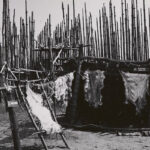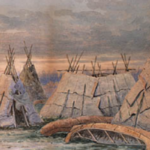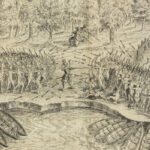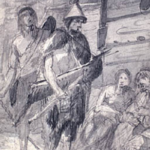The Abenaki First Nation: A Legacy of Resilience and Adaptation
The Abenaki First Nation, represented today by the communities of Odanak and Wôlinak in Quebec, stands as a testament to the resilience and cultural continuity of one of North America’s most enduring Indigenous peoples. Known to themselves as Alnôbak, meaning “The People,” the Abenaki have a deep historical connection to the land that stretches back thousands of years. Their story, rooted in the verdant forests and fertile river valleys of the Northeastern Woodlands, encompasses a rich pre-history, early encounters with European settlers, and centuries of adaptation to profound social and cultural changes. This narrative, marked by strength and survival, reflects the unique aspects of their journey from pre-contact times to the present day.
Pre-History: The Alnôbak and the Northeastern Woodlands
The Abenaki people are part of the larger Algonquian linguistic family, with ancestral territories spanning what is now southern Quebec, New England, and the Maritime provinces. Archaeological evidence points to their presence in the region for over 12,000 years, a history deeply tied to the natural rhythms of the land. Their traditional homelands, known as Ndakinna, included forests, rivers, and coastal areas that provided an abundance of resources.
The Abenaki were semi-nomadic, relying on seasonal cycles to guide their movements. Summers were spent in villages along rivers where they cultivated corn, beans, and squash, known as the Three Sisters, while winters saw smaller family groups disperse into the forests to hunt game such as deer, moose, and bear. Fishing and gathering wild plants, nuts, and berries supplemented their diet. Their reliance on the land fostered a deep spiritual connection to the natural world, which was reflected in their oral traditions, ceremonies, and governance.
Governance and Social Structure
Traditional Abenaki society was organized around extended family units, with clans linked by kinship and shared responsibilities. Leadership was consensus-based, with decisions made collectively by village councils. Chiefs, or sagamores, were chosen for their wisdom and ability to mediate disputes, while elders played a key role as custodians of oral history and cultural knowledge.
The Wigwam, a dome-shaped dwelling constructed from saplings and bark, symbolized the Abenaki’s resourcefulness and connection to the environment. Villages were strategically located near rivers, which served as transportation routes and vital resources for sustenance and trade.
First Contact with Europeans
The arrival of European explorers in the 16th and 17th centuries marked the beginning of profound changes for the Abenaki. French explorers, including Samuel de Champlain, established early contact with the Abenaki during his travels along the St. Lawrence River and into New England. These interactions were initially characterized by mutual curiosity and trade, with the Abenaki providing furs in exchange for European goods such as firearms, metal tools, and textiles.
However, European contact also brought devastating challenges. Diseases such as smallpox and measles, to which the Abenaki had no immunity, decimated their populations. Historians estimate that by the mid-17th century, disease had reduced the Abenaki population by as much as 75%, profoundly disrupting their communities.
Relationships with French Settlers and Jesuit Missionaries
The Abenaki aligned themselves with the French during the 17th century, drawn by shared economic interests and a mutual opposition to English expansion. The French established Jesuit missions among the Abenaki, including those at Odanak and Wôlinak, as part of their broader efforts to convert Indigenous peoples to Christianity. While some Abenaki adopted aspects of Catholicism, many integrated these teachings into their existing spiritual practices rather than abandoning their traditions.
The French-Abenaki alliance was particularly evident during the Beaver Wars and later conflicts such as King Philip’s War (1675–1678) and the French and Indian War (1754–1763). The Abenaki served as scouts and warriors for the French, leveraging their deep knowledge of the land in these engagements.
English Encroachment and Abenaki Resistance
As English settlers expanded into New England, tensions between the Abenaki and the English intensified. English colonists, driven by a desire for land and resources, encroached on Abenaki territories, leading to a series of violent conflicts. The Abenaki, often outnumbered and outgunned, relied on guerrilla tactics and their intimate knowledge of the forests and rivers to resist.
The treaties and land agreements imposed by English settlers frequently disregarded Abenaki sovereignty, further eroding their traditional territories. By the late 18th century, many Abenaki had sought refuge in Quebec, where they established the communities of Odanak and Wôlinak. These settlements became centres of cultural preservation and resilience, offering a sanctuary from the pressures of colonial expansion.
The 19th and 20th Centuries: Challenges and Adaptation
The 19th century brought new challenges for the Abenaki, including the imposition of the Indian Act (1876), which sought to assimilate Indigenous peoples into Euro-Canadian society. The Abenaki faced restrictions on their governance and cultural practices, while the reserve system confined them to smaller portions of their traditional lands.
Despite these challenges, the Abenaki communities of Odanak and Wôlinak demonstrated remarkable adaptability. Many members of the community found work in industries such as logging, farming, and crafting, while others engaged in cultural tourism, sharing their traditions and skills with visitors. Efforts to preserve the Abenaki language and traditions continued, with storytelling, crafting, and seasonal ceremonies remaining integral to community life.
Cultural Revitalization and Resilience
In recent decades, the Abenaki have worked tirelessly to revitalize their cultural heritage. Language immersion programs, traditional crafting workshops, and historical exhibitions have become central to these efforts. The Abenaki Museum in Odanak, established in 1965, serves as a repository of Abenaki history, showcasing artifacts, art, and stories that reflect the community’s rich heritage.
Seasonal celebrations, such as the Odanak Powwow, bring together Abenaki and other Indigenous peoples to celebrate their culture through drumming, dancing, and storytelling. These events not only reinforce community bonds but also educate younger generations about their history and traditions.
Environmental Stewardship and Advocacy
The Abenaki’s deep connection to the land remains central to their identity. Traditional ecological knowledge, honed over millennia, informs their approach to hunting, fishing, and land management. In recent years, the Abenaki have taken an active role in environmental advocacy, addressing issues such as water quality and conservation in their traditional territories.
The communities of Odanak and Wôlinak have also partnered with regional organizations to promote sustainable development, ensuring that their lands and resources are preserved for future generations.
The Abenaki Today: A Thriving Community
Today, the Abenaki communities of Odanak and Wôlinak are vibrant centres of culture and innovation. With populations of approximately 2,000 members, these communities blend traditional practices with modern governance and economic development. Investments in education, healthcare, and infrastructure reflect a commitment to creating opportunities for future generations.
The Abenaki continue to advocate for their rights and recognition, both within Canada and in their ancestral territories in New England. Their efforts highlight the enduring strength of their community and their determination to protect their cultural heritage.
Conclusion: A Legacy of Resilience and Renewal
The history of the Abenaki First Nation is a testament to their resilience, adaptability, and profound connection to the land. From their ancient roots in the Northeastern Woodlands to their central role in early European trade and their modern efforts in cultural revitalization, the Abenaki have maintained their identity and place within Canada’s evolving landscape.
As an elder from Odanak once said, “Our strength lies in our connection to the land, our traditions, and our people. By honouring our past, we build a future that reflects who we are as Abenaki.”
References
- Bouchard, Serge. Caribou Hunter: A History of the Innu People. McGill-Queen’s University Press, 2004.
- Calloway, Colin G. The Western Abenakis of Vermont, 1600-1800: War, Migration, and the Survival of an Indian People. University of Oklahoma Press, 1990.
- Trigger, Bruce G. The Children of Aataentsic: A History of the Huron People to 1660. McGill-Queen’s University Press, 1976.
- Conrad, Margaret. A Concise History of Canada. Cambridge University Press, 2012.
- Abenaki Museum. Guardians of Ndakinna: The History and Culture of the Abenaki. Odanak Publications, 2015.
- Jesuit Relations. Documents of the Missions to New France. McGill University Press, 1962.
- Environmental Justice Advocacy Group. Stewardship and Sovereignty: The Role of the Abenaki in Environmental Advocacy. University of Guelph Press, 2019.
- Snow, Dean R. The Iroquois. Blackwell, 1994.
- Johnston, Basil. Ojibway Heritage. McClelland & Stewart, 1976.
- Ridington, Robin. Trail to Heaven: Knowledge and Narrative in a Northern Native Community. Douglas & McIntyre, 1988.



